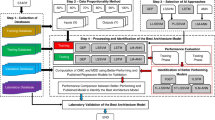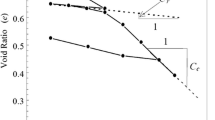The compressibility parameters such as the compression index and the recompression index are necessary in the settlement calculation for fine-grained soils that is essential to geotechnical designs. However, determination of the compressibility parameters from odometer tests takes a relatively long time and leads to a very demanding experimental working program in the laboratory. Geotechnical engineering literature involves many studies based on multiple regression analysis (MLR). This study was aimed at predicting the compressibility parameters by soft computing methods such as artificial neural networks (ANN) and the quasi-Newton algorithm developed with the differential evolution method (QN-DE). The selected variables for each method are the index parameters of natural finegrained soils such as natural water content and initial void ratio. The results obtained from MLR, ANN, and QN-DE models were compared with each other at the end of the study.
Similar content being viewed by others
References
A. W. Skempton, "Notes on the compressibility of clays," Q. J. Geol. Soc. London, 100(1-4), 119-135 (1944).
K. Terzaghi and R. B. Peck, Soil Mechanics in Engineering Practice, 2nd ed, John Wiley & Sons Inc., New York (1967).
A. S. Azzouz, R. J. Krizek, and R. B. Corotis, "Regression analysis of soil compressibility," Soils Found., 16(2), 19-29 (1976).
T. S. Nagaraj and B. R. Srinivasa Murthy, "Prediction of the preconsolidation pressure and recompression index of soils," Geotech. Test. J., 8(4), 199-202 (1985).
M. A. Lav and M. A. Ansal, "Regression analysis of soil compressibility," Turk. J. Eng. Environ. Sci., 25, 101-109 (2001).
G. L. Yoon, B. T. Kim, and S. S. Jeon, "Empirical correlations of compression index for marine clay from regression analysis," Can. Geotech. J., 41, 1213-1221 (2004).
H. I. Park and S. R. Lee, "Evaluation of the compression index of soils using an artificial neural network," Comput. Geotech., 38(4), 472-481 (2011).
W. Bae and T. Y. Heo, "Prediction of compression index using regression analysis of transformed variables method," Mar. Georesour. Geotech., 29(1), 76-94 (2011).
F. Kalantary and A. Kordnaeij, "Prediction of compression index using artificial neural network," Sci. Res. Essays, 7(31), 2835-2848 (2012).
B. Tiwari and B. Ajmera, "New correlation equations for compression index of remolded clays," J. Geotech. Geoenviron. Eng., 138(6), 757-762 (2012).
C. Lee, S. J. Hong, D. Kim, and W. Lee, "Assessment of compression index of Busan and Incheon clays with sedimentation state," Mar. Georesour. Geotech., 33(1), 23-32 (2015).
H. MolaAbasi, I. Shooshpasha, and A. Ebrahimi, "Prediction of the compression index of saturated clays using polynominal models," Sci. Iran. A, 23(2), 500-507 (2016).
I. Lee and J. Lee, "Prediction of pile bearing capacity using artificial neural networks," Comput. Geotech., 18(3), 189-200 (1996).
M. G. Sakellariou and M. Ferentinou, "A study of slope stability prediction using neural networks," Geotech. Geol. Eng., 24(3), 419-445 (2005).
Y. S. Kim and B. T. Kim, "Use of artificial neural networks in the prediction of liquefaction resistance of sands," J. Geotech. Geoenviron. Eng., 132(11), 1502-1504 (2006).
Y. L. Kuo, M. B. Jaksa, A. V. Lyamin, and W. S. Kaggwa, "ANN-based model for predicting the bearing capacity of strip footing on multi-layered cohesive soil," Comput. Geotech., 36(3), 503-516 (2009).
M. H. Bagheripour, I. Shooshpasha, and M. Afzalirad, "A genetic algorithm approach for assessing soil liquefaction potential based on reliability method," J. Earth Syst. Sci., 121(1), 45-62 (2012).
M. H. Baziar, A. Kashkooli, and A. Saeedi-Azizkandi, "Prediction of pile shaft resistance using cone penetration tests (CPTs)," Comput. Geotech., 45, 74-82 (2012).
A. Demir, "New computational network models for better predictions of the soil compression index," Acta Geotech. Slov., 12(1), 59-69 (2015).
H. Bolton, G. Heymann, and A. Groenwold, "Global search for critical failure surface in slope stability analysis," Eng. Optim., 35(1), 51-65 (2003).
A. R. Zolfaghari, A. C. Heath, and P. F. Mc Combie, "Simple genetic algorithm search for critical non-circular failure surface in slope stability analysis," Comput. Geotech., 32, 139-152 (2005).
Y. M. Cheng, "Global optimization analysis of slope stability by simulated annealing method with dynamic bounds and Dirac function," Eng. Optim., 39(1), 17-32 (2007).
Y. M. Cheng, L. Li, S. Chi, and W. B. Wei, "Particle swarm optimization algorithm for location of critical non-circular failure surface in two dimensional slope stability analysis," Comput. Geotech., 34(2), 92-103 (2007).
X. Liu, G. Cheng, B. Wang, and S. Lin, "Optimum design of pile foundation by automatic grouping genetic algorithms," ISRN Civ. Eng., 2012, (678329), 1-16 (2012).
K. Nakanishi and I. Takewaki, "Optimum pile arrangement in piled raft foundation by using simplified settlement analysis and adaptive step-length algorithm," Geomech. Eng., 5(6), 519-540 (2013).
W. Zhao, Z. Xu, and J. Zheng, "Optimization design of piles subjected to horizontal loads based on reliability theory," J. Cent. South Univ., 21(7), 2928-2934 (2014).
B. Zhao, L. Zhang, D. Jeng, J. Wang, and J. Chen, "Inverse analysis of deep excavation using differential evolution algorithm," Int. J. Numer. Anal. Methods, 39, 115-134 (2015).
U. Dagdeviren and B. Kaymak, "Optimum design of reinforced concrete retaining walls using artificial bee colony algorithm," Int. Conf. Civ. Environ. Eng., Nevsehir, Turkey, 1171-1180 (2015).
K. Seitz and J. Grabe, "Three-dimensional topology optimization for geotechnical foundations in granular soil," Comput. Geotech., 80, 41-48 (2016).
S. Haykin, Neural Networks: A Comprehensive Foundation, 2nd ed, Prentice Hall, New Jersey (1999).
G. Zhang, B. E. Patuwo, and M. Y. Hu, "Forecasting with artificial neural networks: the state of the art," Int. J. Forecast., 14(1), 35-62 (1998).
O. Yildiz, "Using artificial neural networks for forecasting USD exchange rates," M.Sc. thesis, Eskisehir Osmangazi University, Eskisehir, Turkey [in Turkish] (2006).
H. Aygoren, H. Saritas, and T. Morali "Forecasting ISE 100 indice using artificial neural networks and Newton numerical search models," Int. J. Alanya Faculty Business, 4(1), 77-78 (2012).
D. Ozgen, " Artificial neural network analyze and Turkish financial marketing: application of IMKB 30 index," M.Sc. thesis, Marmara University, Istanbul, Turkey (2007).
G. Ocakoglu, " Logistic regression analysis and comparison of classification characteristics of artifical nueural network techniques and an application," M.Sc. thesis, Uludag University, Bursa, Turkey (2006).
R. Storn and K. Price, "Differential evolution a simple and efficient adaptive scheme for global optimization over continuous spaces," Technical Report TR-95-012, International Computer Science Institute, Berkeley (1995).
R. Storn, "On the usage of differential evolution for function optimization," Proc. Biennial Conf. North Am. Fuzzy Inform. Process Soc., Berkeley, 519-523 (1996).
R. Schoenberg, Optimization with the Quasi-Newton Method, Aptech Systems, Inc., Maple Valley (2001).
E. M. Gertz, "A quasi-Newton trust-region method," Math. Program Ser. A, 100, 447-470 (2004).
M. Fallgren, "On the robustness of conjugate-gradient methods and quasi-Newton methods," M.Sc. thesis, Royal Institute of Technology, Stockholm, Sweden (2006).
Auto2fit, "CPC-X Software," http://www.geocities.com/neuralpower.
Author information
Authors and Affiliations
Additional information
Translated from Osnovaniya, Fundamenty i Mekhanika Gruntov, No. 3, p. 17, May-June, 2018.
Rights and permissions
About this article
Cite this article
Dagdeviren, U., Demir, A.S. & Kurnaz, T.F. Evaluation of the Compressibility Parameters of Soils Using Soft Computing Methods. Soil Mech Found Eng 55, 173–180 (2018). https://doi.org/10.1007/s11204-018-9522-4
Published:
Issue Date:
DOI: https://doi.org/10.1007/s11204-018-9522-4




